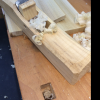I have the opportunity to by some sizable barn beams from white oak for about $2.40 b/f. The beams are 12' long and 4.75x7.75". They have been stored indoors for the last 5 years. Assuming that they are relatively straight, do you think my chances of getting a 8' top that is 4+" thick is reasonable? I was thinking of laminating three to get about 20"x4". Also, this is the first time that I'll be using reclaimed lumber. Aside from nails, is there anything I should be aware of? I wouldn't think that WO would be very susceptible to bugs. Is there a good method for cleaning? Thanks!





 Reply With Quote
Reply With Quote




